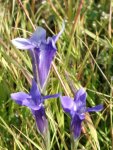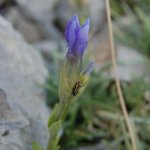Gentian bearded - gentiana barbata
Family Gentianaceae - Gentianaceae
Botanical characteristics. Annual herbaceous plant.
Stem is straight, 6-60 cm tall. Leaves opposite - from linear-lanceolate to elongated narrow-line. The root is shortened, with thin subordinate roots resembling a beard. Flowers are campanulate, blue-violet, large. Fruit is a single-compartmented box. Blossoms in July - August, fructifies in August - September.
Spread. It grows on forest glades, fringes, meadows, wetlands, along the banks of rivers and streams.
Used parts of the plant. The medicinal raw material is the aerial part of the plant, collected in the usual way.
Chemical composition. The aerial part contains alkaloids, xanthones (dekussatin, gentiakohinin) and their derivatives; Flavonoids (apigenin, luteolin, chrysoeriol, thallianin) and their derivatives; Pigments, vitamins.
Application. The above-ground part of the plant, leaves and flowers are used in Tibetan and Mongolian medicine for various diseases; Is one of the main components that make up more than one hundred prescriptions used for diseases of the hematopoietic organs (liver, spleen, bone marrow), in the treatment of hepatitis, cholecystitis, diseases complicated by pneumonia; With acute endocarditis, kidney diseases, septic conditions, chronic infectious diseases, diseases of the gastrointestinal tract. Gentian bearded is included in the Tibetan full collection of "Granat"; Flowers are the main component of the complex prescription of the domestic drug "Agar-35", used for atherosclerosis, rheumatism, heart neuroses, nervous diseases, with tachycardia and dyspnea, pneumonia, nephritis, dry cough, gout.
In Mongolian and Chinese medicine the decoction of leaves and flowers is used as an antipyretic agent for various infectious diseases. In the Far East - with pulmonary tuberculosis, malignant tumors; In Siberia - with diseases of the stomach, dyspepsia, diarrhea, as a restorative.
Experimentally confirmed the effectiveness of decoction and dry extract for acute toxic hepatitis. It is used as an antioxidant, with poisoning, cytoprotective, antihistamine, anti-inflammatory, stimulating processes of regeneration and mitosis of liver cells, as well as coagulating blood system and prothrombin complex; Normalizes the function of the bile ducts, has a positive effect on the immune state of the body.
Preparation. For broth take 20 g of the aboveground part of the plant, chop, pour 200 ml of boiling water, insist on a boiling water bath for 30 minutes, cool 10 minutes, filter. Take 1/3 cup 2-3 times a day after meals.
In connection with the wide pharmacological spectrum of action and relatively small stocks in the wild-growing species, the plant is recommended for introduction into the culture.




Comments
When commenting on, remember that the content and tone of your message can hurt the feelings of real people, show respect and tolerance to your interlocutors even if you do not share their opinion, your behavior in the conditions of freedom of expression and anonymity provided by the Internet, changes Not only virtual, but also the real world. All comments are hidden from the index, spam is controlled.